(1939 products available)






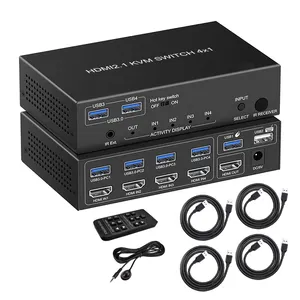







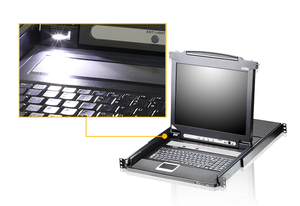
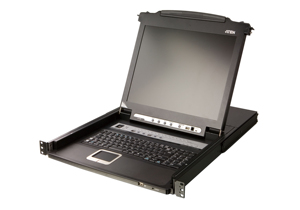
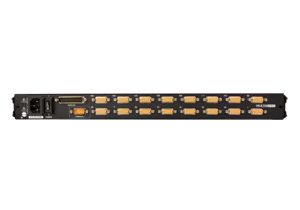










































































































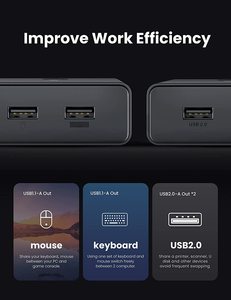
























































































A 2 port KVM switch is a device that allows the user to control two separate computers using one keyboard, mouse, and monitor. It works by connecting the KVM switch to the keyboard, mouse, and monitor on one port and to the two different computers on the other two ports.
Based on connectivity, there are two-port KVM switches:
USB 2 Port KVM Switch:
It allows two computers to share one keyboard, video monitor, and mouse. It is suitable for USB-enabled environments. This switch provides port control to each device by connecting it to a KVM switch. To control the KVM switch, the user will have to divert the port by pressing the button on the device or toggling the command on the keyboard.
The switch cable is included with the KVM USB switch, which makes it easy to set up. However, it only works with USB cables, which means it cannot be connected to older devices that use PS2 ports. A USB KVM switch is also more portable and smaller.
HDMI 2 Port KVM Switch:
This method also allows two computers to share one keyboard, monitor, and mouse, but in this case, HDMI is used as the media through which they are connected. This is particularly useful in instances where the computers have incompatible connections. The HDMI port provides excellent video quality, especially high-definition video. The port can also transmit audio along with the video signal and therefore provides an all-included media experience.
Similar to the USB switch, the HDMI switch also comes in two variations: the cable-based version, where the HDMI cable is used for direct connection between the KVM switch and the devices, and the integrated version, where the HDMI ports are integrated within the KVM device itself.
VGA 2 Port KVM Switch:
VGA KVM switches come with audio supports, USB and PS/2 ports, and wired remote controls. These switches are low-cost and simple solutions for managing shared access to computers. However, they may have limitations, such as inability to transmit audio along with the video signal, and may not provide the high-resolution output that is characteristic of more modern switches and technologies.
DisplayPort 2 Port KVM Switch:
Like other KVM switches, it allows multiple computers to be controlled through one keyboard, monitor, and mouse. However, the method through which it connects is through the DisplayPort technology. It is capable of supporting high-definition resolutions and multiple monitors at the same time. It functions conveniently for users in an environment that requires sharing of peripherals and connection through DisplayPort.
Dual Monitor 2 Port KVM Switch:
This exact switch allows its users to connect two separate monitors in a dual display setup. It meets compliance of high-definition standards such as HDCP, HDMI, and h.264. However, it may need additional adapters and cables, and some models may not support dual monitors.
Multiple Ports:
A 2 port KVM switch has two main types of ports. These include USB and PS/2. The USB port allows users to connect various devices, such as a mouse, keyboard, and other devices. The PS/2, on the other hand, helps connect the keyboard and mouse to the switch using purple and green connectors, respectively. It's important to note that not all KVM switches have both USB and PS/2 ports. The availability depends on the model and version. However, some KVM switches offer the flexibility of using both types of ports, providing compatibility with various devices. This also allows users to connect peripherals according to their preferences and requirements.
Plug and Play:
Plug-and-play refers to the capability of a device to be connected and used immediately without requiring additional configuration or installation steps. In the case of a 2-port KVM switch, plug-and-play functionality means that users can simply plug the switch into the appropriate ports on their computers and servers and start using it right away. There will be no need for complex setup procedures or manual adjustments. This can save users a significant amount of time and effort. It also makes the process of switching between computers or servers more efficient and streamlined.
Space and Energy Saving:
2 Port KVM switches help save a lot of energy and space. This is because they allow users to operate two different computers using just one keyboard, mouse, and monitor. When these three peripherals are shared among two computers, it also means that two sets of these items will not be purchased. The KVM switch works by connecting all these devices into it and connecting the KVM switch to both computers. This doesn't only save space on the desk, but it also saves energy and money that would have been used to buy two separate sets of keyboards, mice, and monitors.
Hotkey Switching:
Hotkey switching is a method that allows users to switch between connected computers or servers using predefined key combinations or hotkeys. This enables KVM switching operation through the keyboard instead of using physical buttons on the switch itself. Using hotkey switching makes switching between computers more efficient and convenient. In cases where the keyboard is not in use or not accessible, hotkey switching allows users to operate the KVM switch from any connected computer. This ensures seamless and flexible access to multiple computers. Hotkey switching enhances the functionality of the KVM switch by providing a practical means of switching between computers using keyboard commands.
Multimedia Support:
Multimedia support refers to the capability of a KVM switch to handle various types of multimedia devices and signals. This includes devices such as speakers, microphones, headphones, audio devices, and video signals. Some KVM switches come with audio and video support, allowing users to transmit audio signals along with video signals. This ensures a complete multimedia experience when using the KVM switch. With multimedia support, users can connect audio devices, microphones, and other multimedia peripherals to the KVM switch. This enables audio recording, communication, and other multimedia functions through the KVM switch.
USB Peripheral Sharing:
USB peripheral sharing is a feature that allows users to connect and use USB devices across multiple computers or servers through a USB device sharing switch. This enables the sharing of USB devices such as printers, scanners, flash drives, webcams, and other USB peripherals. With USB peripheral sharing, users can connect a USB device to the KVM switch and access it from any of the connected computers. This eliminates the need to physically swap USB devices between different computers. It also allows seamless sharing of USB devices in environments where multiple computers are used, such as offices, labs, or home setups.
Dual Computer Control:
The 2 port KVM switch is very effective for people that need to manage two computers while only using one set of keyboard, mouse, and monitor. This small gadget links the two computers and allows switching between them. It is a helpful tool for busy people such as software developers who need to check their work on both a Mac and a Windows computer. It also benefits office workers who want to keep their personal and work computers side by side but only use one set of working tools.
Presenting:
Some KVM switches have extra capabilities that make them better suited for dynamic tasks like showcasing information to a large audience. An example of this is a higher-definition option that enables enhanced visual presentation. This flexibility proves valuable in various fields, including teaching, where it can be utilized to exhibit complicated data charts or illustrative slides to learners in a classroom setting from a laptop. Another use is in boardrooms, where intricate financial tables or analytics can be projected during a meeting.
Silicon Valley effect:
2 Port KVM Switches greatly assist programmers and computer security experts whose work demands alternating between various systems on a single display. For programmers tackling multiple coding tasks across diverse operating systems, this device makes managing many projects on distinct PCs easier—all from one set of peripherals. It also benefits IT security staff monitoring different servers and detecting potential risks; by keeping them all visible at once, they can respond rapidly to issues that arise anywhere.
Computers:
Customers need to look at the types of computers that are compatible with the KVM switch they intend to buy. Usually, KVM switches are designed for specific applications. For example, a KVM designed for a standard application will support all standard computers such as PCs, MACs, and laptops. However, customers with unique computer types such as servers, headless computers, or custom-built machines should go for KVMs that support such devices. The reason behind this is that standard KVMs only offer basic connectivity and functionality while unique computers require advanced features and connectivity options that match their specifications.
Cables:
It is important for buyers to know that some 2 port KVM switches come with built-in cables while others require additional purchasing of the cables to connect to the computers and peripherals. Cables play a crucial role in facilitating connections, so getting the right type is very important. Customers should check the models' specifications and ensure they understand the compatibility of the KVM switch with various cable types. This includes USB, HDMI, DisplayPort, DVI, VGA and PS/2 among other types. In case the switch doesn't support any of the above cables, users should be ready to use converters and adapters to connect to their computers and peripherals.
Keyboard and mouse support:
A KVM switch allows one to control two different computers using a common keyboard and mouse. However, the kind of keyboard and mouse that the switch can support depend on the kind of PS/2 or USB ports available on the KVM switch. Moreover, some 2 port KVM switches have the ability to support independent keyboard and mouse extenders. This provides flexibility in using a separate keyboard and mouse while still controlling two different computers.
Audio support:
For customers planning to use their KVM switch to transmit audio between computers and peripherals, they might need to purchase additional audio cables. Generally, KVMs have basic audio transmission capabilities. However, for more advanced audio transmission and to ensure seamless sound transfer between devices, it is recommended to buy a KVM with a strong audio support system. The audio capabilities of KVMs vary with models. Therefore, users should check the audio support specifications of the specific model they intend to purchase.
Peripheral support:
Different 2 port KVM switches allow users to connect two computers and use the same set of peripherals. Peripherals are the external devices that are attached to the computer such as keyboards, mice, monitors, and speakers among others. However, some KVM switches only support PS/2 or USB inputs for peripheral connection. Also, the specific peripherals supported by a KVM switch depend on its model. While some models allow users to connect a common set of peripherals, others enable the connection of independent peripherals to each computer.
Q1: Are 2-port KVM switches simple to set up?
A1: Yes, 2-port KVM switches are simple to set up and do not need complicated installation procedures. Users only need to connect the keyboard, monitor, and mouse to the KVM switch's output ports, as well as connect the switch's two input ports to the respective computers.
Q2: What advantages do 2-port KVM switches offer?
A2: 2-port KVM switches enable control and management of two computers using a single keyboard, mouse, and monitor. This minimizes cable clutter, enhances productivity by facilitating quick switching between systems, and finds use in situations like dual system setups and remote IT support.
Q3: What is the purpose of a KVM Switch?
A3: A KVM ("Keyboard, Video, and Mouse") switch allows a user to control multiple computers with a single keyboard, monitor, and mouse. A KVM switch consists of a set of keys that determine which computer is currently active.
Q4: Do 2-port KVM switches support audio?
A4: Many 2-port KVM switches do support audio, which allows the transmission of audio signals along with video and data. This enables the user to use speakers, microphones, and other audio devices connected to the KVM switch for both computers.